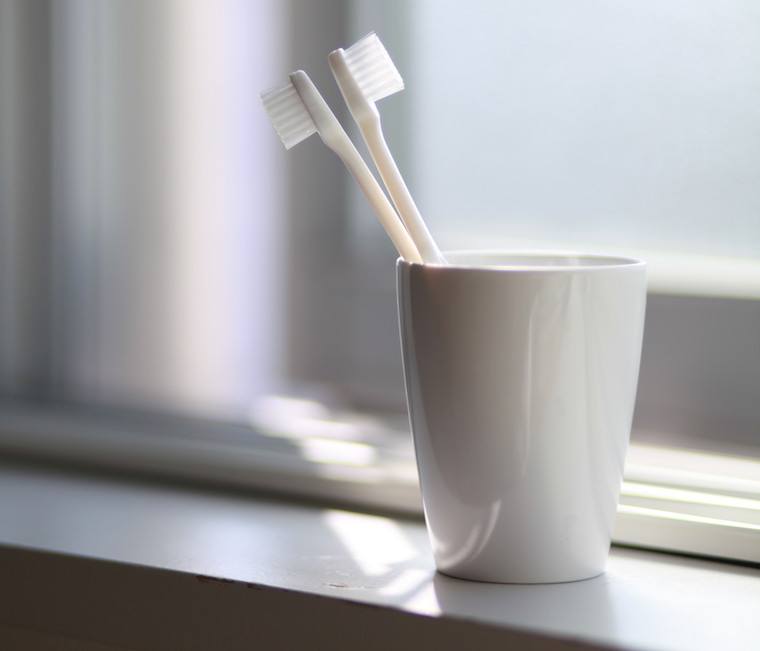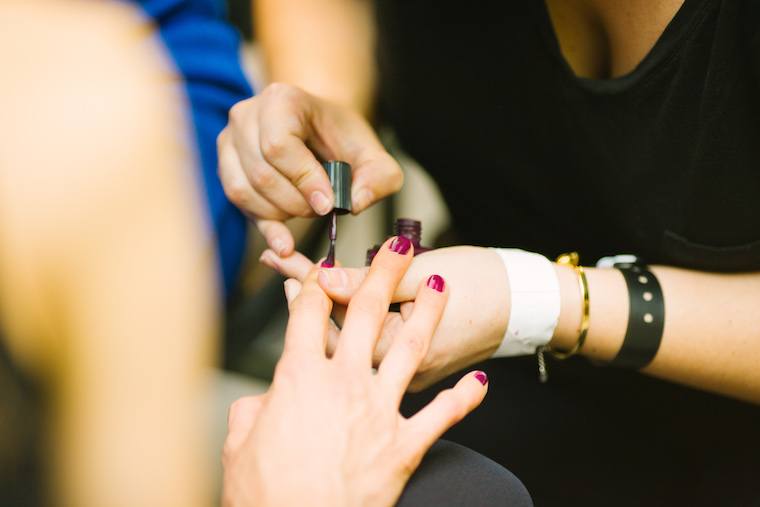One of the best times to detox your body is when there is a change of season, but these practices can be done all year long or whenever you feel like you need a boost. I do these daily and like to think of the process as a daily mini retreat I do for myself. It's a moment where I can have a dialogue with my body. These five rituals will take less than 15 minutes a day, so enjoy yourself while you give your body an opportunity to get rid of toxins and thrive. Other benefits? During the process you become more aligned, have more energy, and are ready to face the day. Plus you will feel great thanks to the time you have decided to take for yourself.
The set up of your bathroom is important as it helps you relax. Switch off the light, light candles, and put on some relaxing music. This takes less than a minute to set it up. I invite you to do it, it’s good for you!
1. Dry body brushing
Brushing our teeth two to three times a day is feels so natural, it's habitual. Believe it or not, our bodies needs brushing too, just like our hair and teeth! Dry body brushing is a great way to detoxify your body and eliminate over a pound of waste a day! The skin is the body’s largest organ and it eliminates 25 percent of the toxins in your body each day, which equates to over a whole pound of waste! Every minute we lose over 30,000 dead skin cells, which are replaced by new healthy skin cells.
How to do it: Use a brush with soft natural bristles, preferably with a longer handle. Synthetic bristles often contain chemicals that are best to avoid. Begin brushing at your feet and work your way slowly up the body with long sweeping motions, always brushing towards the heart. When dry brushing the stomach it is best to go in a clockwise motion as that works with the natural digestive flow.
The skin may be slightly flushed afterwards but it should not be red or sore. Be sure to avoid brushing over fresh wounds, burns and cuts. The skin should be dry but not excessively dry when brushing. If you shower after brushing, it will help remove exfoliated skin cells.
Benefits: It stimulates the lymphatic system and helps with muscle tone. It removes dead skin cells. It makes your skin softer, smoother, and tighter by increasing the flow of blood, and improves circulation, which reduces the appearance of cellulite. It also improves digestion, reduces stress, and energizes your whole body.
2. Hot towel scrubbing
This is like living a spa experience at home! Body scrubbing can be done before or after your bath or shower, or anytime during the day. All you need is a sink with hot water and a medium-sized cotton washcloth. Doing it at the sink has a deeper physical, mental, and emotional effect than doing it in the shower. For a maximum effect, scrub your body twice a day: once in the morning and once again in the evening. Scrub for 2 to 20 minutes, depending on the amount of time you have.
How to do it: Turn on the hot water and fill the sink. Add a few drops of lavender essential oil if you wish. Hold the towel at both ends and place in the hot water. Don’t burn yourself! Wring out the towel. While the towel is still hot and steamy, begin to scrub the skin gently. Do one section of your body at a time: for example, begin with the hands and fingers and work your way up the arms to the shoulders, neck and face, then down to the chest, upper back, abdomen, lower back, buttocks, legs, feet, and toes. Scrub until the skin becomes slightly pink or until each part becomes warm. Reheat the towel often by dipping it in the sink of hot water after scrubbing each section, or as soon as the towel starts to cool.
Benefits: This activates the lymphatic system. It calms the mind, reduces muscle tension, relieves stress, and helps spread energy through your chakras. It helps you create a profound and loving relationship with your body. It promotes circulation and opens the pores to release stored toxins. Done it the morning, it will reenergize you and it deeply relaxes you at night.
3. Coconut oil pulling
How to do it: Before you eat or drink anything, put ½ to 1 tablespoon of coconut oil in your mouth. Swish it around for 5 to 20 minutes. At first, you might feel disgusted having oil in your mouth. Start with 30 seconds and keep at it as you will feel the benefits quite rapidly. While you are swishing it becomes toxic so spit carefully into garbage bin or toilet. Not in the sink as it will clog it up. Then rinse your mouth a couple times and wash your teeth.
Benefits: Coconut oil pulling will kill cold and flu germs, and bad breath. It whitens the teeth, prevents cavities and gingivitis, and strengthens the gums. It heals cracked and dry lips, reduces inflammation, decreases bacterial load in the mouth, detoxifies the body, and helps regulates hormonal imbalance.
4. Tongue scraping
Tongue scraping is simple and inexpensive, yet completely transformative!
A tongue scraper is a thin, U-shaped device made of stainless steel or plastic, consisting of a blunt edge that removes build-up from the surface of the tongue. It originated in Ayurveda, which says that people who use it are more expressive and thoughtful, better public speakers, and more sincere and authoritative conversationalists. Interesting, huh?
How to do it: Apply a few quick strokes after brushing your teeth. Use the round edge to scrape gently down, while applying slight pressure. Rinse under running water and gently scrape again until no white residue is left.
Benefits: It helps fight cavities and prevents bad breath. It reduces excess mucus in the mouth, and in turn the nose and throat. It reduces cravings greatly and resensitizes your taste buds, which makes whole foods taste more delicious than ever. It even enhances kissing by making the tongue more fresh. You're welcome.
5. Water with lemon
Lemons are jam packed with nutrients, including vitamin C, B complex vitamins, calcium, iron, magnesium, potassium, and fiber. They contain more potassium than apples and grapes!
Because of how hard lemon juice can be on the enamel of your teeth, it’s important to dilute it with water of any temperature (though lukewarm is recommended). Drink it first thing in the morning, and wait 15 to 30 minutes to have breakfast. This will help you fully receive the benefits of lemon water.
The popular belief is that lemons are very acidic. Yes they are! But inside the body, lemons are one of the most alkalizing foods.
Benefits: Lemon water gives your immune system a boost. Thanks to its excellent source of potassium, it’s good for your heart health, as well as your brain and nerve function. It aids digestion and cleanses your system by flushing out the toxins. It decreases blemishes and wrinkles, and gives radiance to your skin. It reduces inflammation and helps your lose weight by fighting hunger cravings. It gives you an energy boost, and reduces anxiety and depression—smelling the fragrance of lemon essential oil has a calming effect on the nervous system.
I recommend you try this mini retreat at least once a week, or by integrating different elements daily. Enjoy every minute of this sacred moment you will create for yourself.








